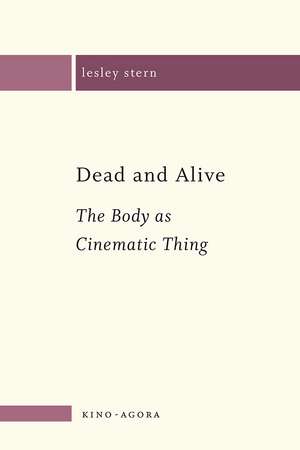Dead and Alive: The Body as a Cinematic Thing: Kino-Agora
Autor Lesley Sternen Limba Engleză Paperback – 31 dec 2022 – vârsta ani
In the cinema many were living and many kept on living and many became dead, as Gertrude Stein might say. Some kept on living and some kept on being dead and some became things. Bodies proliferate in cinema. Living bodies to be sure, but also dead bodies, and transitional bodies, suspended between the being of a subject and objecthood. We tend to use the same word to designate both a living and a dead body. We also, of course, use the word ‘corpse’. Dead is dead, no doubt, but if there are degrees of deadness then a corpse is probably deader than a dead body.
Lesley Stern is more interested in things than in death. It is thus the liveliness of corpses that lures her. Not dead bodies which act as though they were alive, nor live bodies which may really be dead, nor bodies which may in fact be composited, or even digitally constructed bodies. Rather, ordinary, old-fashioned bodies, bodies once living and now dead which exhibit a performative potential for conjuring a quality of cinematic thingness. They are bodies that insist on existing after they are dead. In some films in which dead bodies persist, time is concentrated in the body. And dispersed. When life leaves the body, time–or a particular quality of time–enters into the body, and into the film. The body, then, becomes an index of cinematic temporality.
Published by caboose books, Montreal. Distributed worldwide, excluding Canada, by Rutgers University Press.
Lesley Stern is more interested in things than in death. It is thus the liveliness of corpses that lures her. Not dead bodies which act as though they were alive, nor live bodies which may really be dead, nor bodies which may in fact be composited, or even digitally constructed bodies. Rather, ordinary, old-fashioned bodies, bodies once living and now dead which exhibit a performative potential for conjuring a quality of cinematic thingness. They are bodies that insist on existing after they are dead. In some films in which dead bodies persist, time is concentrated in the body. And dispersed. When life leaves the body, time–or a particular quality of time–enters into the body, and into the film. The body, then, becomes an index of cinematic temporality.
Published by caboose books, Montreal. Distributed worldwide, excluding Canada, by Rutgers University Press.
Preț: 80.15 lei
Nou
Puncte Express: 120
Preț estimativ în valută:
15.34€ • 16.40$ • 12.79£
15.34€ • 16.40$ • 12.79£
Carte indisponibilă temporar
Doresc să fiu notificat când acest titlu va fi disponibil:
Se trimite...
Preluare comenzi: 021 569.72.76
Specificații
ISBN-13: 9780981191454
ISBN-10: 0981191452
Pagini: 60
Dimensiuni: 140 x 191 mm
Ediția:Nouă
Editura: Caboose
Colecția caboose
Seria Kino-Agora
ISBN-10: 0981191452
Pagini: 60
Dimensiuni: 140 x 191 mm
Ediția:Nouă
Editura: Caboose
Colecția caboose
Seria Kino-Agora
Notă biografică
LESLEY STERN is a professor in the department of visual arts at the University of California at San Diego. She is the author of The Scorsese Connection and The Smoking Book and coeditor of Falling for You: Essays on Cinema and Performance. Her essays have appeared in Screen, M/F, Camera Obscura, Film Reader, Image Forum, Trafic, Emergences, and Critical Inquiry.
Descriere
Bodies proliferate in cinema. In some films in which dead bodies persist, time is concentrated in the body. And dispersed. When life leaves the body, time – or a particular quality of time – enters into the body, and into the film. The body, then, becomes an index of cinematic temporality.


